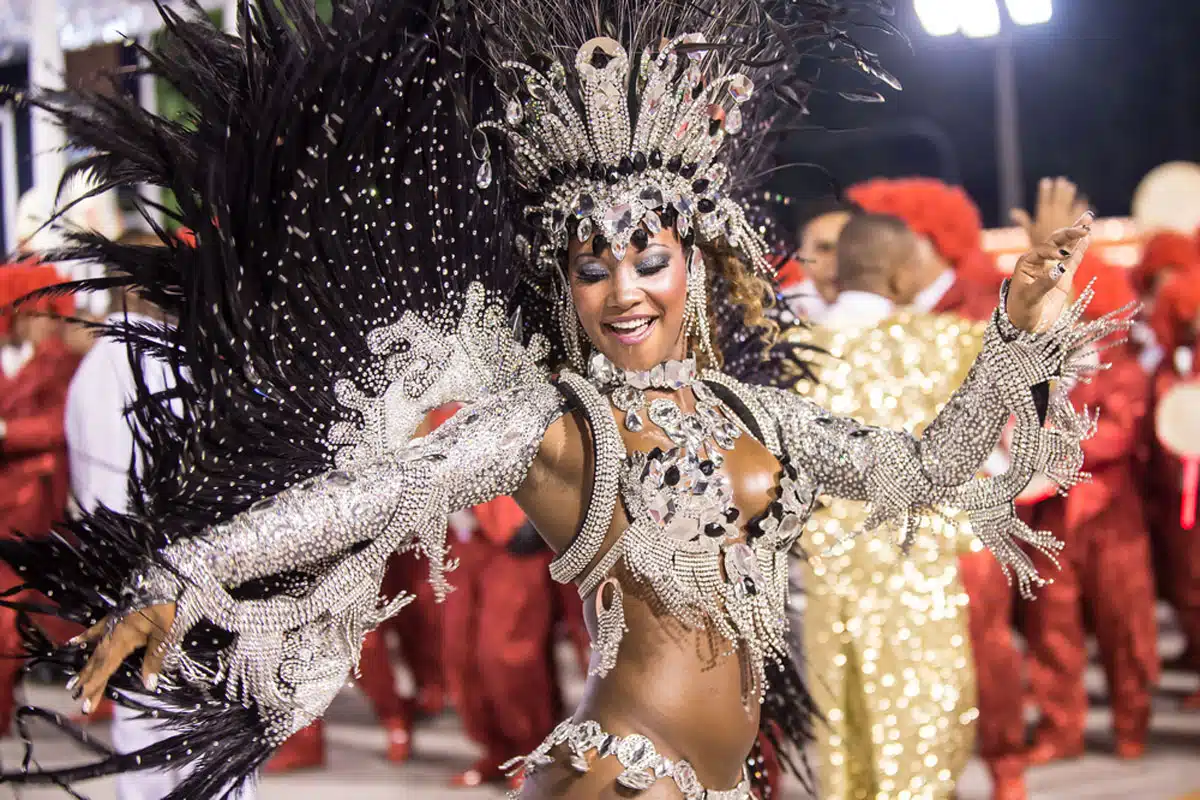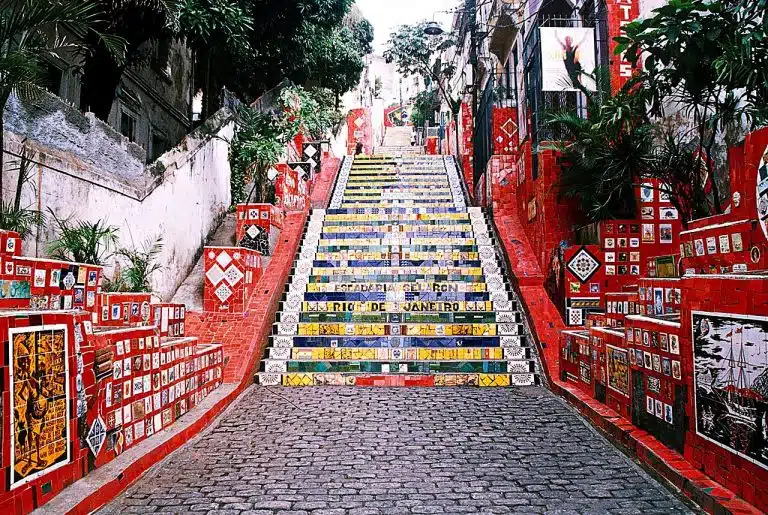Walk down the streets of Rio the weekend before Ash Wednesday and take note of the brightly coloured costumes and intoxicating rhythm of samba drums. Ready to attend the greatest party on earth? Welcome to the Rio de Janeiro Carnival.
Close your eyes and imagine the endless thumping of the Afro-Brazilian samba music weaving through alleyways in nearly every neighbourhood in Rio. The rhythms drive locals and tourists to dance in the streets and beaches in cut-off tees and swimsuits in the days (and even weeks) leading up to the big party.
Once you enter the Sambadrome, you’ll witness thousands of performers and spectators, the line often blurred by elaborate costumes, song, and dance both in the stands and on the street. You’ve quite literally never seen anything like it. I certainly hadn’t.
Carnival first came to Rio de Janeiro in the 18th century. But it didn’t really resemble the party we know of today until the 1920s.
Truly a reflection of Brazil’s complicated history and rich cultural traditions, the addition of costumes, masks, and samba music showcase European, African, and Indigenous influences like nowhere else on the planet.
But when is Carnival? Where should you stay? How can you attend the event like a local? Not to worry.
Here’s my guide on everything you need to know about Rio de Janeiro’s Carnival.
Understanding Rio Carnival
Is the Rio Carnival the greatest show on earth? Quite likely.
From the rowdy but inviting street festivals led by local bands working their way down the city streets to the Sambadrome and its meticulously orchestrated (and competitive) parade or the black-tie balls, the final days leading up to Lent are extraordinary.
Every year, the festivities start the Friday before Lent, and events take place non-stop through Fat Tuesday.
You can literally party around the clock, but the parades, street festivals, and concerts from Saturday to Monday are the most exciting.
The Sambadrome: The Main Event
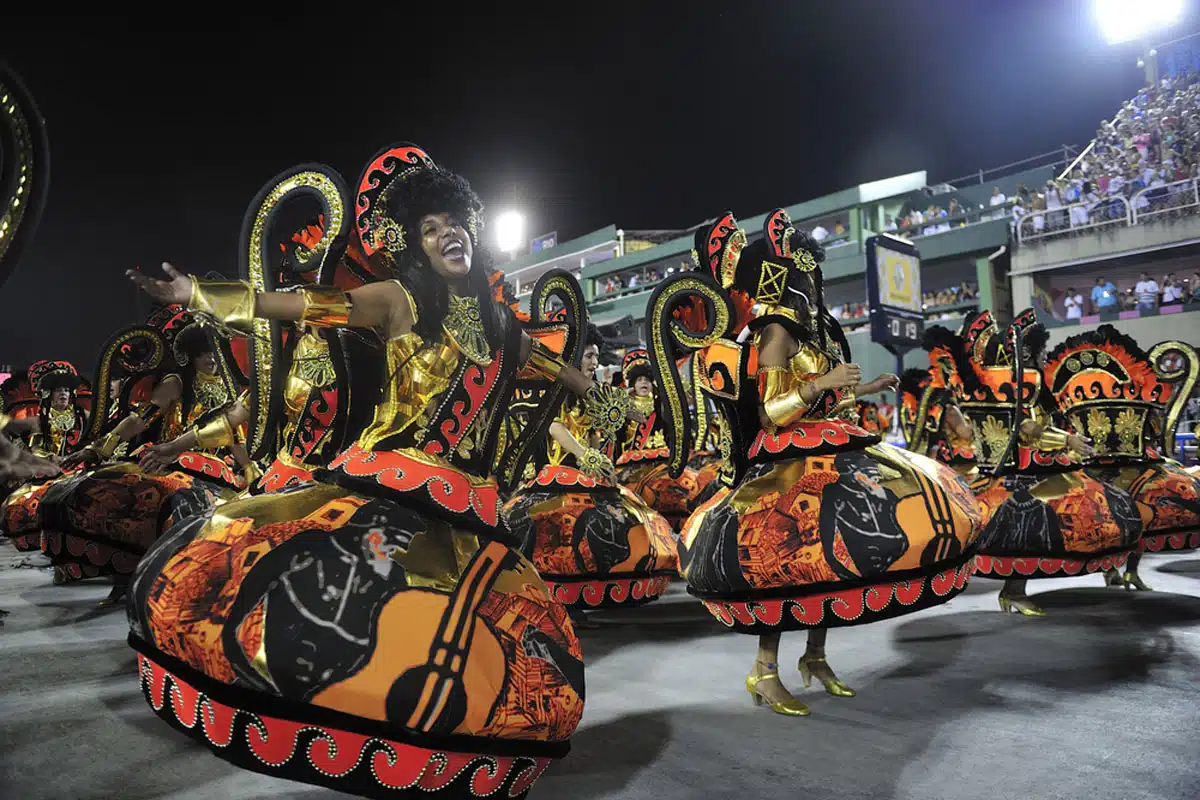
If you’re visiting the Rio de Janeiro Carnival, you have to attend the main event at the Sambadrome (Sambódromo). You just do.
Where is it? The stadium is located on Marques de Sapucai Avenue (downtown) and is open for Carnival events on 5 different nights.
You’re attending the party, but it’s also fiercely competitive.
The Grand Prize
Many of Rio de Janeiro’s famed samba schools compete to take home around £320,000 ($400,000). How? A panel of experts judges the choreographed performances involving elaborate costumes, beautiful samba percussion, and dancing while most of the world is still asleep.
How much does this mean to the musicians and dancers involved? The schools practise for an entire year before the event. Really.
The Criteria
Each group has between 65-75 minutes to perform and is evaluated on 10 different categories by a panel of 4 judges.
Categories involve things like how well they stuck a theme (Enredo), how synchronized the parade was, detail of the costumes (Alegorias e adereços), and the Comissão de frente e alas, which is like the first impression, or front lines, with the best costumes and performances.
Attending the Parade

You’ll need to choose which day(s) you want to go. The parade is actually a series of 5 different performances. Here’s a look at each evening’s events.
Access Group
The first 2 days involve 8 samba schools per night, leading up to the much more celebrated Special Group.
Each school participates in approximately 45-minute sessions during the Access Group for a chance to compete in the Special Group next year.
But don’t think this isn’t worth going. It’s much cheaper, and many of the schools are as talented as some you’ll find in the next round.
Special Group

6 groups perform each night over 2 nights, with a chance to make it to the final event the following weekend.
This is it. What you’ve been waiting for. The costumes, the samba, and the atmosphere is off the charts. These are the best samba schools in Rio de Janeiro on one stage.
Champions Parade
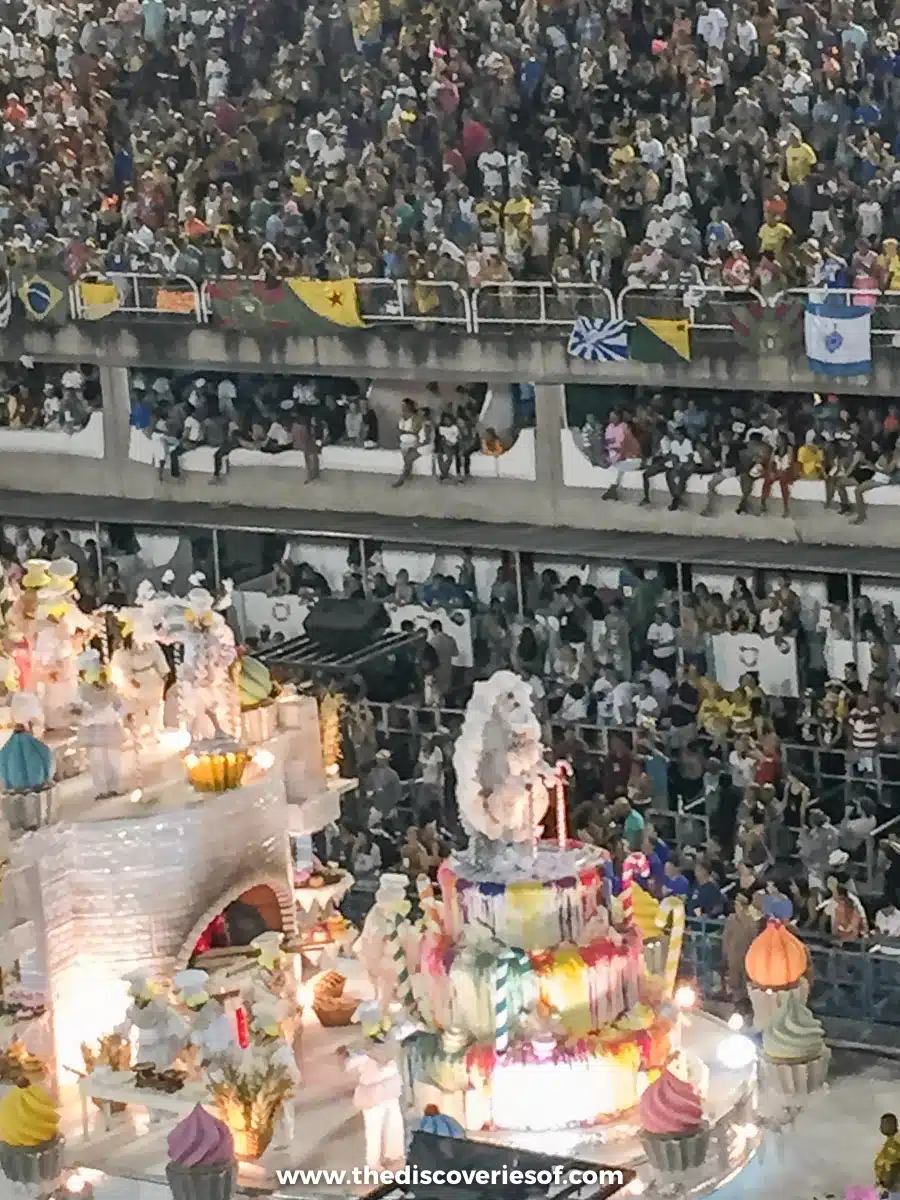
Want to see who wins it all? You’ll need to wait until the following weekend.
The final 6 groups compete during the weekend after Ash Wednesday and have another full hour to impress the judges.
How to Buy Tickets
The best way to buy tickets for the Sambadrome is through Bookers International as far in advance as you can.
Prices vary depending on the seats and the night you want to go. The cheapest seats are in the Grand Stand and start around £93 ($117) for the Special Group.
Here’s a look at a few of the ticket options.
Grandstands
The Grandstands are the cheapest sweats, and you can choose from a few different levels. Sector 2 is the cheapest, and they gradually get slightly more expensive (along with having better views) until you reach the tourist area, Sector 9.
Sector 9 starts around £60 ($77) but includes assigned seating, which is a nice perk that other areas of the Grandstands don’t offer.
Allocated Chairs
In addition to Sector 9, there are other ways to get assigned seating. You can choose Allocated Chairs (Sector 12). These start around £120 ($150) but offer more comfortable seats and a convenient location.
Box Seats
Box seats are a great option if you’re in a group or want a smaller section with excellent views. You can choose either Front Box or Covered Box seats, each with different price tiers relative to the zone.
Folia
If you really want to party, Folia offers guests the unique experience of watching the Main Event from a nightclub near Sector 6.
You’ll have amenities like food, cocktails, private shows, and comfortable seating. But it’s considerably more expensive at over $600 per ticket.
Top Tip
If you want to save some money, you can attend the Access Group events on the first 2 nights for much less.
Blocos: Local Carnival Parties
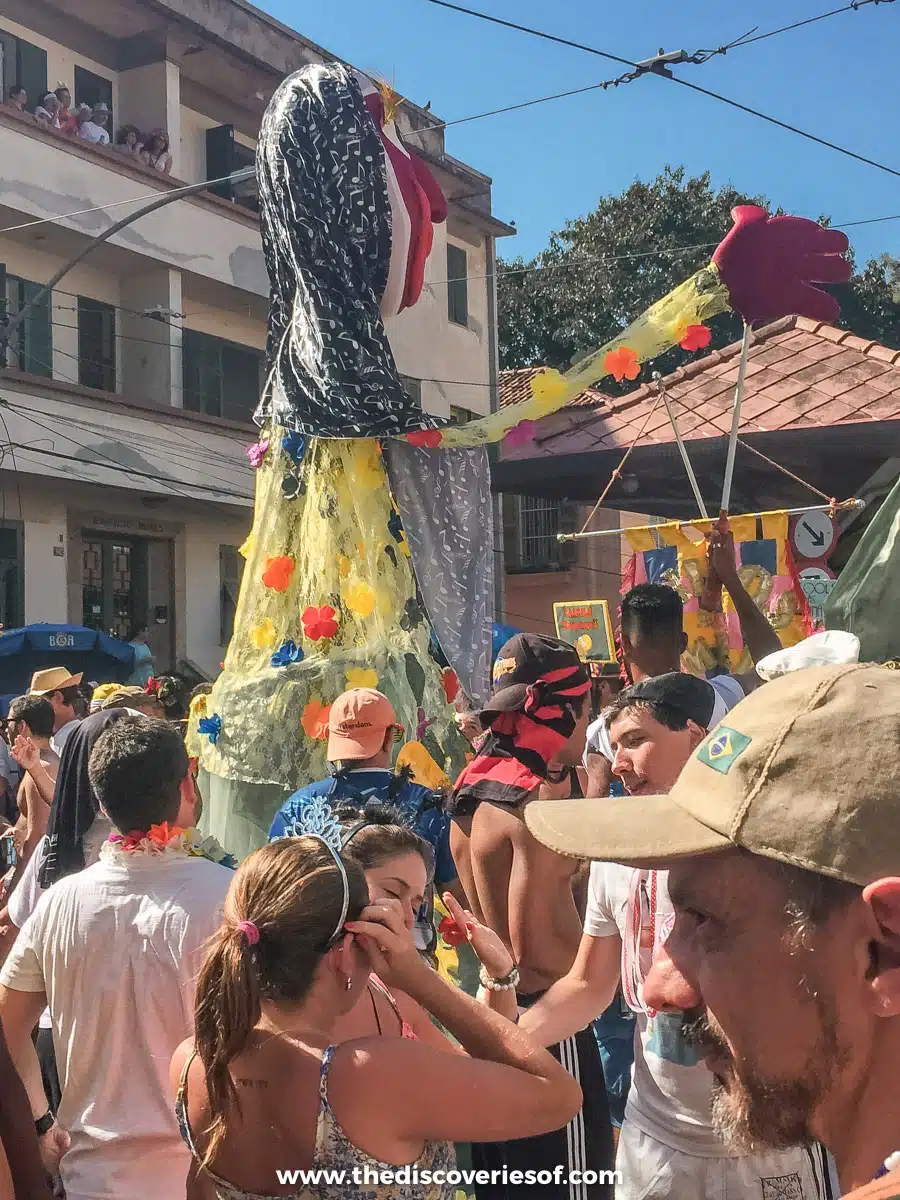
If you’ve already hit the main event (or just want to warm up for it), visit one of the hundreds of Blocos in just about any neighbourhood throughout the sprawling city.
They’re free, fun, and popular with locals and tourists. What’s not to love?
What is a Bloco

First things first, what exactly is a Bloco? It’s a lot like it sounds – a block party.
But this isn’t your everyday neighbourhood get-together. No, it’s so much more. Each Bloco is a celebration of song and dance, with a local band playing Samba, Xote, and other percussion-fueled music.
The festivities and music are organised, but also spontaneous.
Expect them to ebb and flow, often moving from one part of the city to another. Sometimes reaching a full stop before popping up in another part of town.
Blocos often start weeks before the main party at Carnival and can carry on for days after. Think of them as the world’s greatest pre-game leading up to Brazil’s biggest party of the year.
Finding the Blocos:

So now you know what they are, but how do you find the best Bloco when there are over 500 throughout Rio? I’m here to help.
First things first, you’ll want to go to more than one.
And the good news is that the parties are at all hours of the day. Many of the best Blocos even kick off in the morning, as early as 7 am.
But, how do you find the best parties? If you chat with any local, they’ll tell you about a few standouts. Some neighbourhoods even have more than one.
A few of the most popular are the massive parties at Cinelandia and Banda de Ipanema and the Beatles-themed Sargento Pimenta. There’s even Santa Teresa’s Carmelitas, which celebrates a nun who (legend has it) literally leapt from a convent to partake in Carnival. Why not?
But those are just a few of the best.
Top Tip
If you want to discover the next best parties, download Blocos de Rua on Google Play or Apple. The free app is your best resource for locating parties and knowing when they start.
Participating in a Bloco
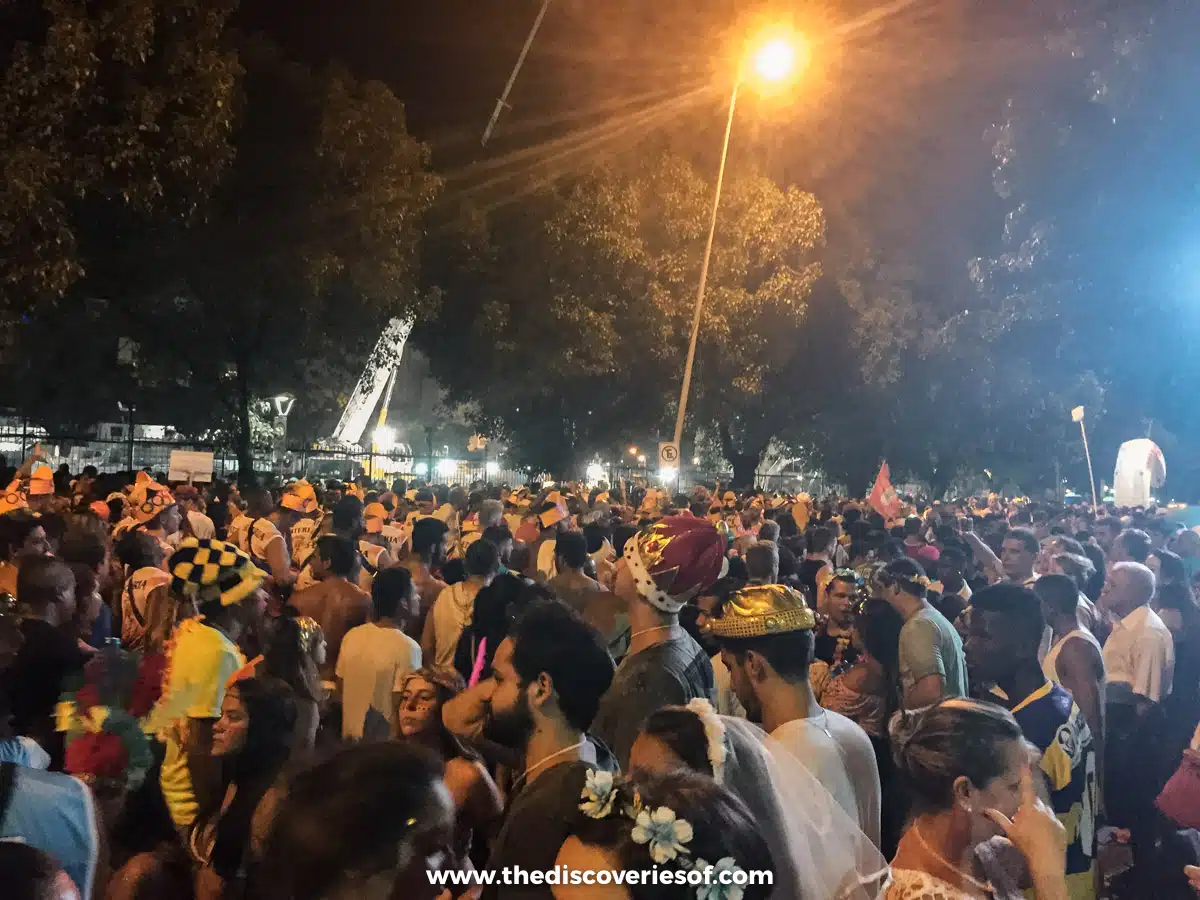
Blocos take on the personalities of the neighbourhood and its residents. They often also have a theme, ranging from a genre of music to a specific band (like the Beatles or New Kids on the Block).
Research the party beforehand and decide which Bloco you want to attend. Once you’re there, be respectful, dress the part if you wish to, and most importantly, have fun.
There aren’t too many do’s and don’ts, but I just stress (like any other time) acceptance and open-mindedness. Participate in the dances, smile and chat with friendly locals, and do your best to have a good time while remaining respectful.
Street Parties
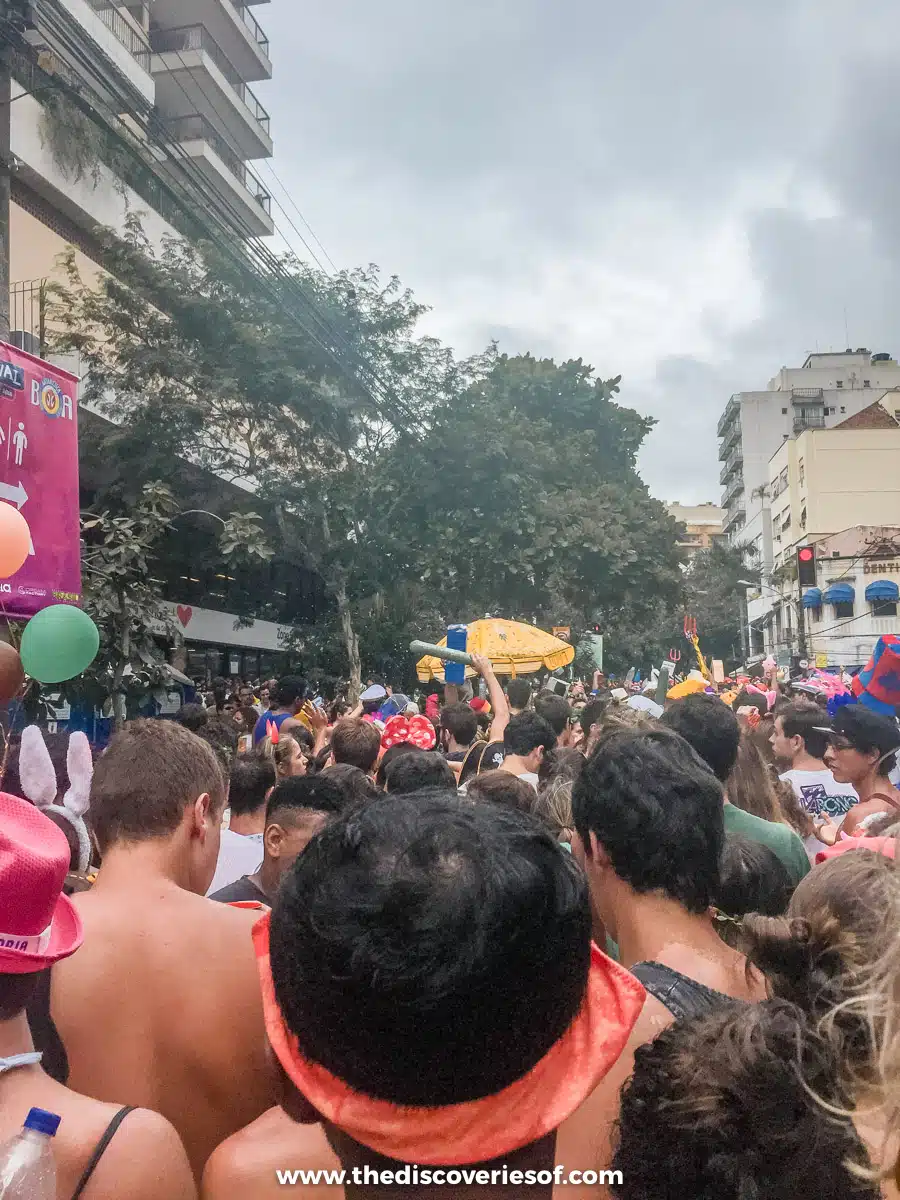
When you participate in street parties and Blocos, getting into the spirit is important. But at the same time, you need to party responsibly and respectfully.
It might be tempting to have a few too many bevvies, and by all means, have some. But have your wits about you and remain courteous to others. Take your trash with you, learn the dances and traditions by watching how locals party, and try to socialise with locals.
You’ll also want to move out of the way for the buses when the bands come through and head over to the sidelines if you can’t keep up with the pace.
Carnival Balls
The Carnival Balls are yet another kind of party you can choose when you visit Carnival. If you’d rather dress up in your finest evening dress or suit, this is your kind of Carnival.
There are various ticketed events throughout town at hotels and clubs, but none with the prestige and allure of the Magic Ball at Copacabana Palace. This black-tie event requires you to dress in your best attire or a grande costume and is frankly a bit stuffier than the Blocos or the Main Event.
It’s a very public affair, with celebrities abound, and you sign a waiver acknowledging you may be recorded. So be on your very best behaviour, even after all the champagne. Trust me.
Tickets: You can try to secure tickets to the Magic Ball here, but they tend to sell out as fast as they release them, and they cost as much as £2,000 ($2,500 each).
The Importance of The Samba Schools
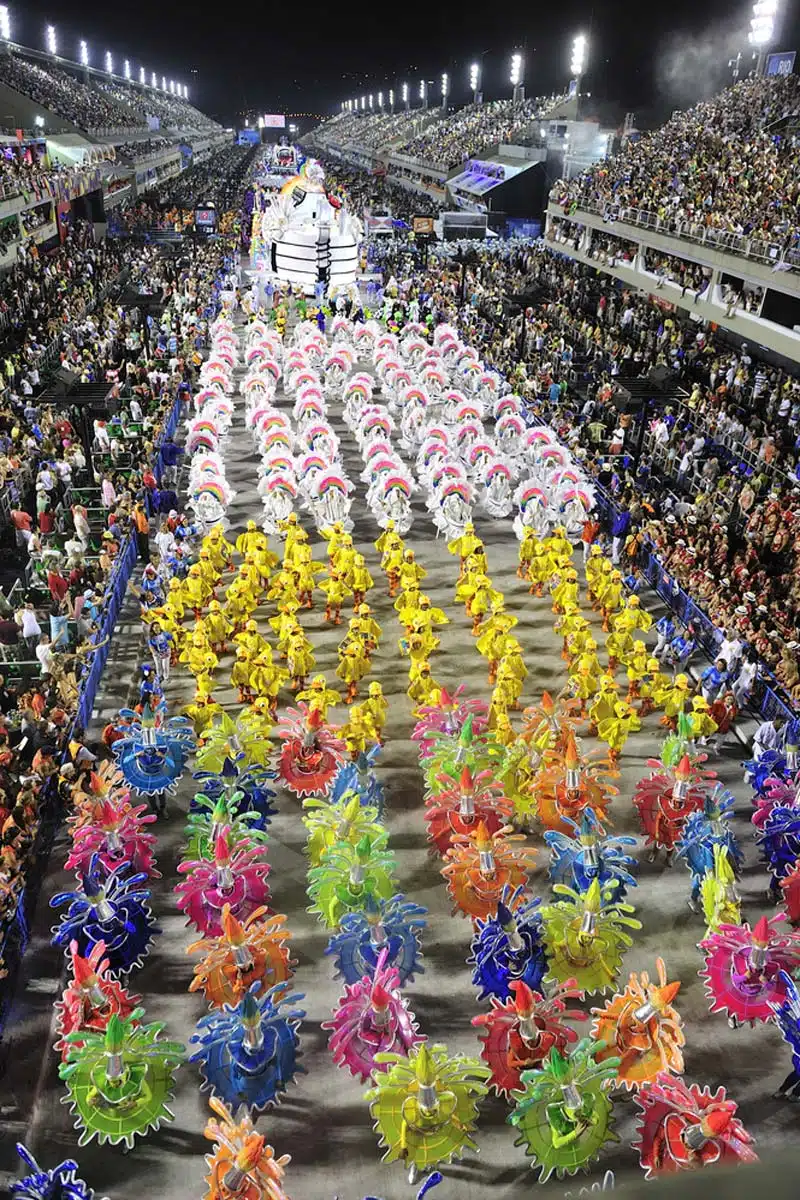
If you attend Carnival, you know it’s all about samba. From the Blocos to the Main Event, the pulse and rhythm of samba drums literally move through the city for the duration of the party.
At the heart of this are the samba schools.
So, what exactly are the samba schools? Neighbourhoods organise a group of performers dedicated to a specific theme, often related to an important cultural event or symbol. The schools have been a vital part of the culture of Carnival and Rio itself since the 1920s.
In the past, winners have based their school around local poets like Manoel de Barros or Brazil’s history and religious traditions.
The schools go to great lengths to tell a story, with hundreds of people dancing down the streets of the Sambadrome to the infectious beat of samba and using costumes, decorated floats, and “wings” or sections of 100+ performers participating in the Main Event.
Top Tips for Making the Most of Your Rio Carnival Experience
One of the coolest aspects of Rio Carnival is how immersive it is. Do everything you can to get into the action and learn how to dress and celebrate by making friends with locals.
Get off the beaten path, join as many block parties as you can, and experience Carnival at street parties or even house parties if you have the opportunity.
Dressing for the Carnival
Now, the fun part. Knowing how to dress for Carnival Rio de Janeiro.
It’s actually a lot easier than you might think. Here’s a look at what to wear to different Carnival events.
Street Parties
If you’re attending a street party, just hit up a local store for the best costume ideas. You can find these in many of the popular shopping districts, like Leblon or Ipanema Beach.
You don’t need to go too over the top for the Blocos. Wear your favourite beachwear and spruce it up a bit with makeup, hats, and glitter. Lots and lots of glitter.
Sambadrome

If you’re attending Sambadrome as a guest, wear comfortable clothing and feel free to improvise as you do at the block party. But think more like something you’d wear to a restaurant instead of the beach.
But if you want to participate in the Main Event (yes, anyone can), you can order a costume from the samba school and literally join the party.
Joining a Samba School
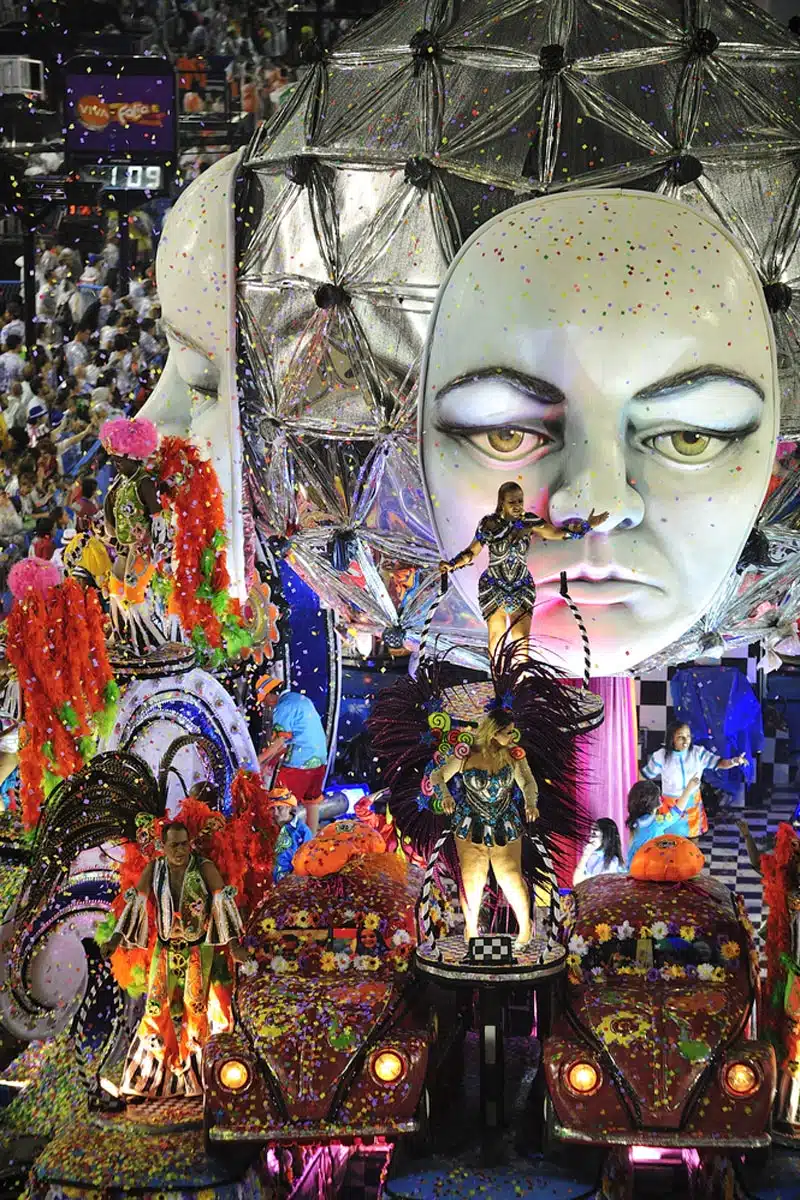
How do you get out and experience Carnival like a local? Join a samba school. I mean it, anybody can do it.
Purchase the costume from the samba school of your choice, and you are an official member of the party!
That said, you’ll want to study music and dance because you’re now officially representing that school, so the pressure is on.
Dance Classes
If you want to participate in the parade, you can learn about the dance by dropping by for a weekly workshop for free at the samba school of your choice. Contact them before you arrive for a schedule or to inquire about digital resources.
Attending dance classes is an excellent way to learn about the culture and festivities before the big party and help you prepare for the show.
Safety and Security
Carnival in Rio de Janeiro is generally safe, but there are some things you’ll want to keep in mind.
Pickpocketing is very common, and you’ll only want to bring items you absolutely need. Keep your cash and phone close to your body, and it wouldn’t hurt to have a money belt that you wear underneath your clothing.
If you attend any events that require tickets, book them in advance through an official vendor. Blocos are typically free, so don’t fall for anyone trying to sell you tickets to enter.
Top Tip
Avoid negotiating with scalpers, as many of them sell fake or overpriced tickets.
Planning Your Trip to Rio During Carnival

Planning your trip to the Carnival in Rio is very important. After all, the city sees over 1.5 million tourists most years.
Hotels fill up fast, and waiting until the last minute can cost you over 5 x the normal price of a hotel. I’d recommend booking your flight and accommodations at least 6 months ahead.
Where to Stay
Don’t wait too long to book your accommodations. The most popular neighbourhoods, like Ipanema or Copacabana, fill up months ahead and are much more expensive than normal.
My advice? Check out other spots around town, like Flamengo and Santa Teresa.
These are safe neighbourhoods and have wonderful Blocos that you can walk to from most accommodations. Check early and often, and try not to wait until the last minute.
I recommend Vila Galé Rio de Janeiro for its central location close to the Santa Teresa Blocos and Sambadrome.
Check Rates and Availability for all Accommodation in Rio de Janeiro
Getting Around Town
Your best chance of getting around town is via the subway system. Whether you’re moving from one Bloco to the next or want to attend the main event, the subway is just the easiest way to get around.
Each train ride costs around £.80 ($1) and is much faster than taking the bus or even a taxi during the celebrations.
You can also walk from one street party to another, which will help save you time compared to navigating the busy streets.
Additional Resources
Tickets and Tours
You can use other websites, like Bookers International, which is a reputable source for buying Rio Carnival tickets.
Carnival Websites
There are a lot of excellent resources you can use to learn more about Rio Carnival. RioCarnival.Org is the official website by Bookers International and has excellent information about the parade and private balls during Carnival.
You can also learn more about the Sambadrome and access a seating chart on Sambadrome.Com.
Carnival Tours
You can go on your own or schedule a guided excursion like this excellent backstage tour on GetYourGuide. You’ll learn more about the costumes and dances from the people putting on the event with a local expert.
Another option is planning your entire trip with a local guide like this tour with Intrepid Travel.
Local Hospitals
Hospital Municipal Souza Aguiar is the closest option if you’re attending the main event in the Sambadrome. You can find directions via taxi here.
Many Blocos are in neighbourhoods with medical facilities, but you will absolutely want travel insurance. Most hospitals won’t treat you without proof of proper coverage.
Tourist Police
If you have any issues that you need to discuss with law enforcement, contact Delegacia Especial de Apoio ao Turismo (DEAT). Their address is:
Av. Afrânio de Melo Franco, 159 – Leblon, Rio de Janeiro – RJ, 22430-600, Brazil.
Emergency Contacts
In the unfortunate event of an emergency, here are some numbers you’ll want to have handy.
DEAT
+55 21 2332-2924
U.S Consulate General
+55 21 3823-2000
Ambulance
192
Read More Rio Guides
- The Ultimate Rio de Janeiro City Guide
- A Weekend in Rio: Epic 2-Day Itinerary
- Incredible Things to do in Rio
Love This? Save and Share on Pinterest



